Top Ten Female Characters From Books Or Television
Top Ten Female Characters from Books or Television
2) Nita Callahan
Favorite quote: “Wow, who sold you that one? I think I’ll go ennoble a couple waffles.” (And basically all of books 6 and 9 where she saves the day)
Nita is my favorite book heroine ever. From the very beginning, I related to her completely for her love of reading and learning, and for being made fun of for it. She is one of the most relatable characters I’ve ever come across. She’s young, but seems so much older- whether because of the wizardry and the responsibility that comes along with it, or because everyone always feels like they’re more mature than the world thinks they are. She shows us that you don’t have to be a respected adult to change (or to save) the world. She’s insecure, selfish, moody (like when she snaps at Kit for no reason), but she also can admit when she’s messed up and learns from her mistakes. She considers giving up wizardry and her best friend to save her mother. She almost goes through with sacrificing herself to save the world (even though she wasn’t too happy about it when she first found out that’s what she got herself into) when she was what, 12/13? She’s quick in a crisis, and very smart. In A Wizard Alone, she taught me so much about grieving, and I wished those books had been there for me when my own mom passed away (though I was probably a bit too young then). Not to mention that in A Wizard Alone she singlehandedly saves the day, using what the Lone Power tried to use to bring her down to bring It down, and save Darryl and Kit. She also nearly singlehandedly saves the day in A Wizard of Mars, not letting her jealousy or anger get in the way of what needed to be done, while also being rather bad ass about it. Nita taught me that it’s okay to be angry- you can use it to your advantage. She helped to teach me that what people think of you doesn’t matter. The people who made fun of/beat up Nita didn’t know that she helped save their lives more than once, and she never let them color her view of humanity. She never once doubted that their lives weren’t worth saving, despite how they treated her. She showed me that being a good sister doesn’t mean you can’t fight and tease each other sometimes. She went from being very dependent on Kit- always giving her power to him, helping him rather than the other way around- to being a very good, independent wizard who stands on her own and stands tall.
More Posts from Outofambit and Others
I would find a way to be there.
wowww
things that would be expensive: renting an RV
things that would actually probably be less expensive: inventing technology for teleports
INFORMATION I WAS NOT PREPARED TO LEARN. MAYBE WE *ARE* ALONE. BECAUSE WE ARE SO *EARLY*. IF THERE IS EVER GALACTIC CIVILIZATION THEY WILL NOT REMEMBER US AT ALL. BECAUSE WE ARE NOTHING. CELLS, JUST BEGINNING TO FORM LIFE. SORRY FOR SCREAMING. BUT ARE YOU LISTENING. ARE YOU THINKING ABOUT IT.
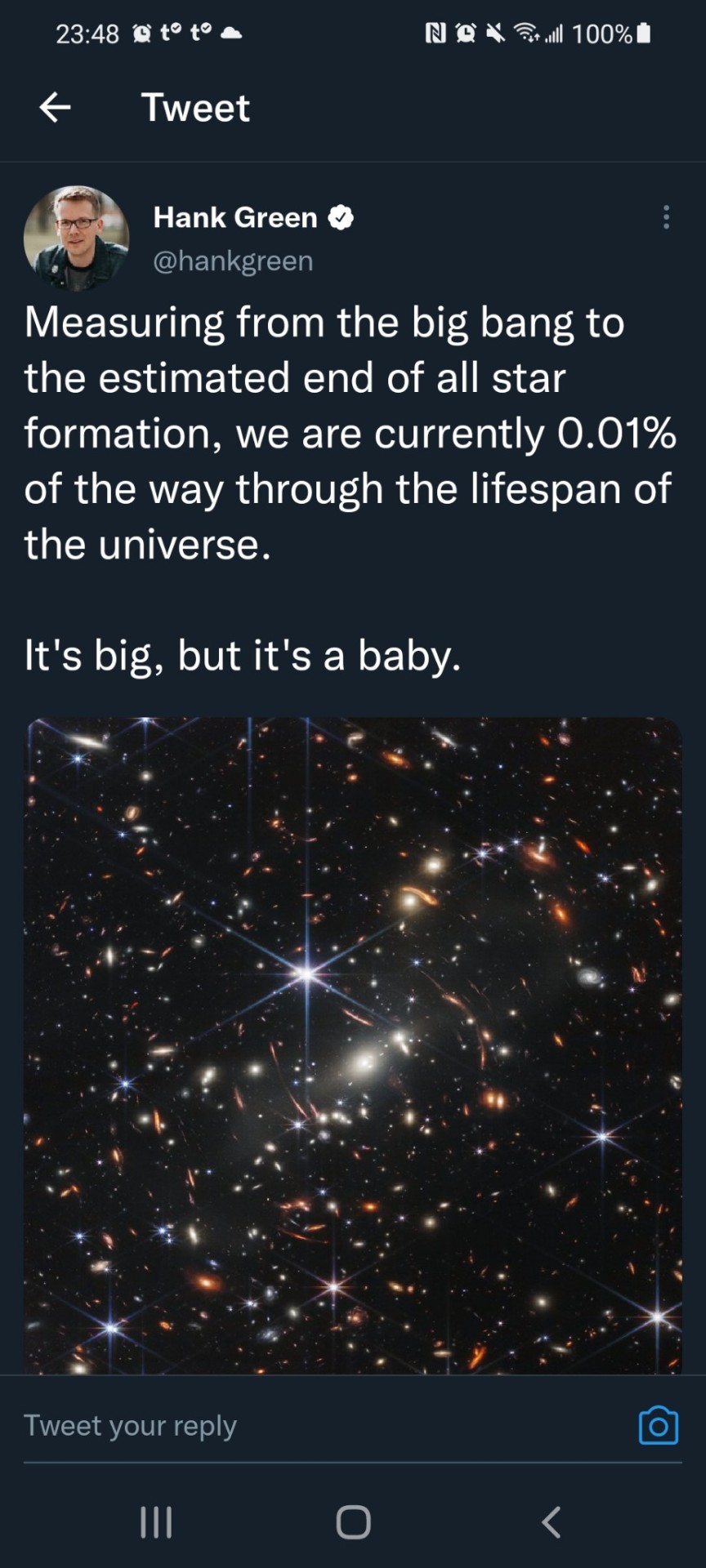

Finally! A black hole that you can visit and survive!
Want a trip through a black hole without having to experience that pesky death? You’re in luck. There’s a special kind of black hole that’s not just survivable, but might get you to another time, or another universe.
Black holes are, traditionally, the scariest things in the universe. Huge, mysterious, inescapable, they wander through the universe and eat everything that gets too close. “Too close” is defined by their event horizon. This is the point at which they go dark, because it requires so much energy to escape them that not even light can get away. Since not even a photon can cross the barrier, no event that happens inside the horizon can ever have an effect on people outside.
Unless, something very odd was going on in the center of the black hole. Most black holes spin - this is something that was discovered way back in the 1960s by physicist Roy Kerr. It wasn’t exactly a shock, because most of the material that collapses into a black hole was already spinning. Sometimes, however, the spin on Kerr black holes goes a little above and beyond. Ever spun a glass of water, or soda bottle, so that the liquid inside swirls? Sometimes, if you spin it enough, the liquid actually parts, leaving a clear center and a spinning ring of water around it. The same kind of thing can happen in Kerr black holes. Instead of a singularity at the center, there’s a ring. And you can go through the open portion of that ring without touching the gravitational crush.
What’s on the other side? A lot of people have wondered. Some people think that these kind of black holes might be our key to time travel. They might be wormholes that let us hop between different points of the universe. Or they might be portals to different universes entirely. First we’ll have to find a few, and then we’ll need a few volunteers to go through. Preferably ones that haven’t seen Event Horizon.
Top Image: NASA/JPL-Caltech
Second Image: Dana Berry/NASA
Via NASA, Astrophysics Spectator, Discovery.


(MIKE FUCK OFF WE’VE BEEN OVER THIS ALREADY I H8 U NO LOVE)
im cryin this is what im doing with my life wowowow a ma zing !!
Space is so creepy and wonderful. Who the hell needs hell when there’s space.
Like there’s an old constellation called Eridanus that you can see in the southern sky, and its not a very interesting constellation. It’s a river. It’s actually the water that’s pouring out of Aquarius, so in the sky it’s kind of boring. It’s a path of stars.
But within Eridanus, in between the stars, there’s a place where the background radiation is unexplainably cold. Because after the Big Bang, there was all this light that scattered everywhere, and it’s the oldest light in the universe, but we can’t see it. It’s so dim that it only shows up as a glow of microwaves, so to us, it just looks like the blackness of the night.
But there’s this spot in Eridanus where that little glow of ancient microwaves isn’t what it should be. It’s cold and dark.
And it’s enormous. Like a billion light year across. Of mostly just emptiness. And we don’t know why. One theory is that it’s simply a huge void, like a place where there are no galaxies. Voids like that do exist. Most of them are smaller, but they’re a sort of predictable part of the structure of the universe. The cold spot in Eridanus, if it were a void, would be so enormous that it would change how we understand the universe.
But another theory is that this cold spot is actually the place where a parallel universe is tangled with our own.



rebloggable by request - what exactly is young wizards?

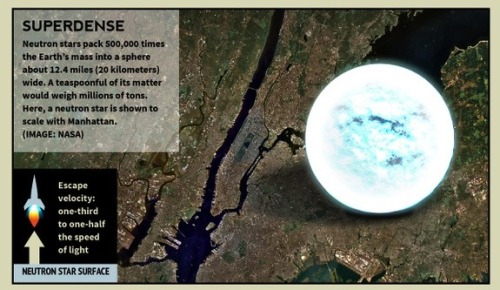
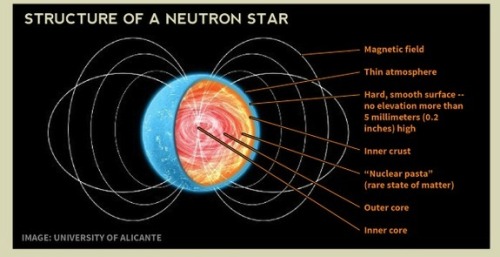
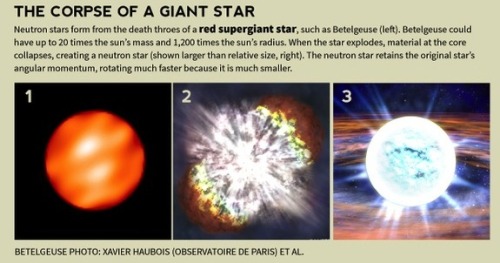
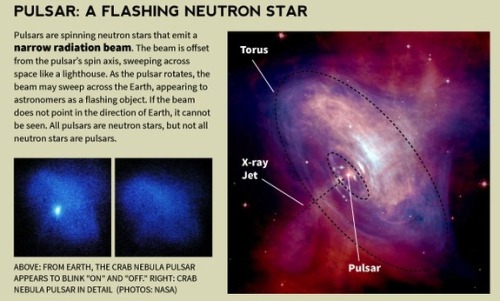

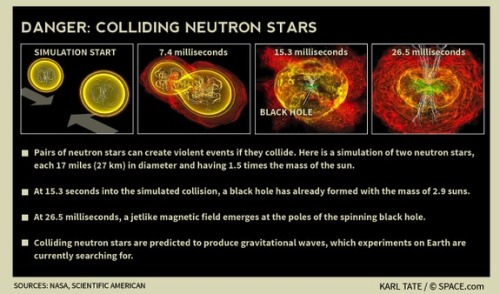
Inside a Neutron Star
Credit: Karl Tate, via SPACE.com
What Have We Learned About Pluto?
This month (March 2016), in the journal Science, New Horizons scientists have authored the first comprehensive set of papers describing results from last summer’s Pluto system flyby. These detailed papers completely transform our view of Pluto and reveal the former “astronomer’s planet” to be a real world with diverse and active geology, exotic surface chemistry, a complex atmosphere, puzzling interaction with the sun and an intriguing system of small moons.
Here’s a breakdown of what we’ve learned about Pluto:

1. Pluto has been geologically active throughout the past 4 billion years. The age-dating of Pluto’s surface through crater counts has revealed that Pluto has been geologically active throughout the past 4 billion years. Further, the surface of Pluto’s informally-named Sputnik Planum, a massive ice plain larger than Texas, is devoid of any detectable craters and estimated to be geologically young – no more than 10 million years old.

2. Pluto’s moon Charon has been discovered to have an ancient surface. As an example, the great expanse of smooth plains on Charon is likely a vast cryovolcanic flow or flows that erupted onto Charon’s surface about 4 billion years ago. These flows are likely related to the freezing of an internal ocean that globally ruptured Charon’s crust.

3. Pluto’s surface has many types of terrain. The distribution of compositional units on Pluto’s surface – from nitrogen-rich, to methane-rich, to water-rich – has been found to be surprisingly complex, creating puzzles for understanding Pluto’s climate and geologic history. The variations in surface composition on Pluto are unprecedented elsewhere in the outer solar system.

4. Pluto’s atmosphere is colder than we thought. Pluto’s upper atmospheric temperature has been found to be much colder (by about 70 degrees Fahrenheit) than had been thought from Earth-based studies, with important implications for its atmospheric escape rate. Why the atmosphere is colder is a mystery.

5. We know what Pluto’s atmosphere is made of. The New Horizon spacecraft made observations of sunlight passing through Pluto’s atmosphere. We see absorption features that indicate an atmosphere made up of nitrogen (like Earth’s) with methane, acetylene and ethylene as minor constituents.

6. We might have an idea for how Pluto’s haze formed. For first time, a plausible mechanism for forming Pluto’s atmospheric haze layers has been found. This mechanism involves the concentration of haze particles by atmospheric buoyancy waves, created by winds blowing over Pluto’s mountainous topography. Pluto’s haze extends hundreds of kilometers into space, and embedded within it are over 20 very thin, but far brighter, layers.

7. There isn’t much dust around Pluto. Before the flyby, there was concern that a small piece of debris (even the size of a grain of sand) could cause great damage to (or even destroy) the spacecraft. But the Venetia Burney Student Dust Counter (an instrument on the New Horizons spacecraft) only counted a single dust particle within five days of the flyby. This is similar to the density of dust particles in free space in the outer solar system – about 6 particles per cubic mile – showing that the region around Pluto is, in fact, not filled with debris.

8. Pluto’s atmosphere is smaller than we expected. The uppermost region of Pluto’s atmosphere is slowly escaping to space. The hotter the upper atmosphere, the more rapid the gasses escape. The lower the planet’s mass, the lower the gravity, and the faster the atmospheric loss. As molecules escape, they are ionized by solar ultraviolet light. Once ionized, the charged molecules are carried away by the solar wind. As more Pluto-genic material is picked up by the solar wind, the more the solar wind is slowed down and deflected around Pluto. So - the net result is a region (the interaction region), which is like a blunt cone pointed toward the sun, where the escaping ionized gasses interact with the solar wind. The cone extends to a distance about 6 Pluto radii from Pluto toward the sun, but extend behind Pluto at least 400 Pluto radii behind Pluto - like a wake behind the dwarf planet.

9. Pluto’s moons are brighter than we thought. The high albedos (reflectiveness) of Pluto’s small satellites (moons) – about 50 to 80 percent – are entirely different from the much lower reflectiveness of the small bodies in the general Kuiper Belt population, which range from about 5 to 20 percent. This difference lends further support to the idea that these moons were not captured from the general Kuiper Belt population, but instead formed by the collection of material produced in the aftermath of the giant collision that created the entire Pluto satellite system.
Make sure to follow us on Tumblr for your regular dose of space: http://nasa.tumblr.com
Started this blog because everyone needs a place to dump their space porn and YW fandom stuff....right?
-
 locaphi liked this · 3 years ago
locaphi liked this · 3 years ago -
 autisticace liked this · 9 years ago
autisticace liked this · 9 years ago -
 aurltas liked this · 10 years ago
aurltas liked this · 10 years ago -
 iridescentoracle liked this · 11 years ago
iridescentoracle liked this · 11 years ago -
 outofambit reblogged this · 11 years ago
outofambit reblogged this · 11 years ago -
 kenporusty liked this · 11 years ago
kenporusty liked this · 11 years ago -
 jenesaispourquoi reblogged this · 11 years ago
jenesaispourquoi reblogged this · 11 years ago -
 evolution-revolution liked this · 11 years ago
evolution-revolution liked this · 11 years ago -
 xxxdragonfucker69xxx liked this · 11 years ago
xxxdragonfucker69xxx liked this · 11 years ago -
 jenesaispourquoi liked this · 11 years ago
jenesaispourquoi liked this · 11 years ago -
 independence1776 liked this · 11 years ago
independence1776 liked this · 11 years ago -
 walkingoutintherain liked this · 11 years ago
walkingoutintherain liked this · 11 years ago -
 toitaliclygo reblogged this · 11 years ago
toitaliclygo reblogged this · 11 years ago
A personal temporospatial claudication for Young Wizards fandom-related posts and general space nonsense.
288 posts